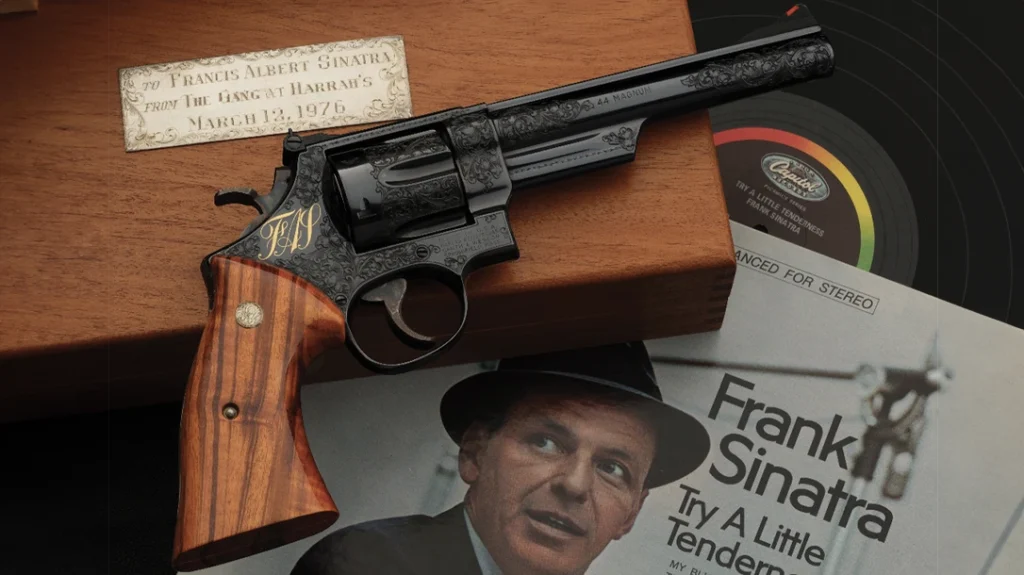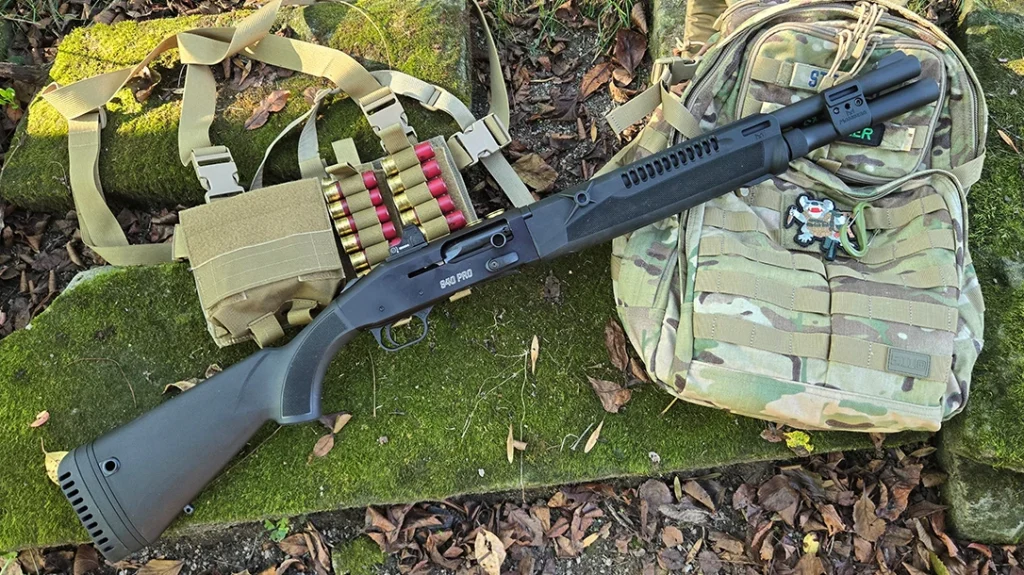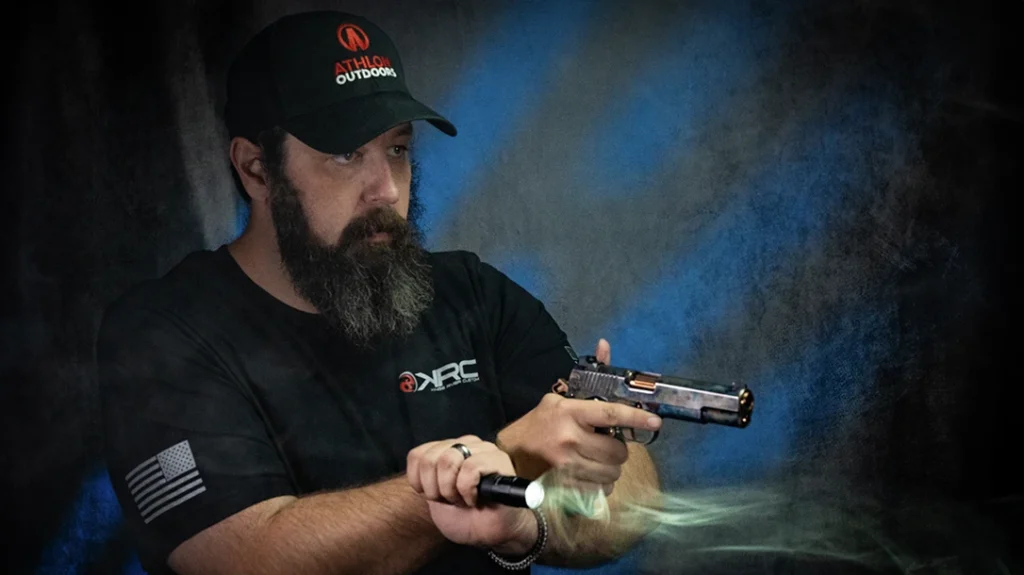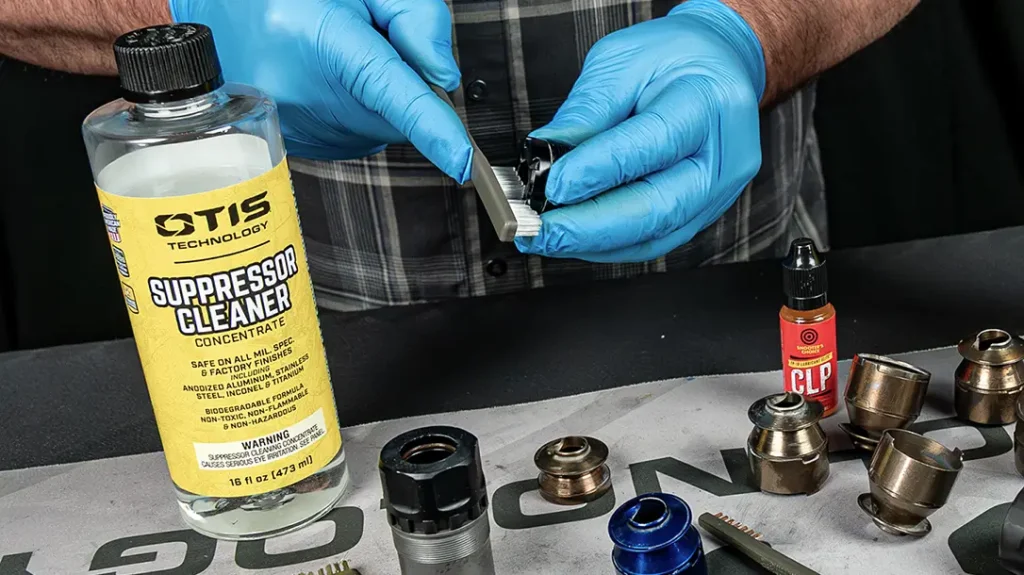This Israeli-made Mark XIX Desert Eagle .44 Mag is a classic example of ingenuity combined with brute power and force.
There are very few guns that are as iconic as Magnum Research’s massive Desert Eagle. But in the last few years the Desert Eagle has been tough to find on dealer’s shelves. That’s all about to change. Kahr Arms purchased Magnum Research Inc. (MRI) in summer of 2010 and is doing their best to fill the pipeline and satisfy the demand for the Desert Eagle.
In 1979 Magnum Researcher’s founders, Jim Skildum and John Risdall started the process of transforming paper blueprints into a behemoth autopistol. Pistols were originally manufactured in Israel by Israel Military Industries (IMI) until 1995 when MRI relocated manufacturing to Saco Defense in Maine. In 1998 MRI moved its manufacturing back to IMI, which had been reorganized as Israel Weapons Industries (IWI). In 2009 MRI started manufacturing the Desert Eagle at their Pillager, Minnesota factory, but to help bolster their supply of guns while they were bringing domestic production fully on line, MRI contracted with IWI to again produce guns. My test sample is a version of this Israeli-made gun. It should be noted that while the gun is machined overseas that MRI controls the specifications, patents and all licenses for the Desert Eagle. IWI is simply a contractor to help MRI satisfy the seemingly endless demand for this gun.
Advertisement — Continue Reading Below
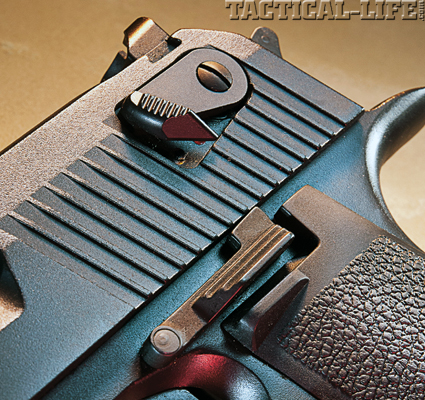 The slide-mounted ambidextrous safety of the Desert Eagle is swept up to disengage.
The slide-mounted ambidextrous safety of the Desert Eagle is swept up to disengage.
Gun Details
If you’ve never picked up the Desert Eagle you’re in for a surprise. It is a monster! Weighing close to 4.5 pounds it is truly a handful. But what makes the Desert Eagle a truly unique gun is its design. The Desert Eagle uses a short-stroke piston not unlike that used in the M1 Carbine. Gas passes through a hole underneath the bore into the gas cylinder where it pushes the piston. This inertia drives the slide back where the bolt unlocks after the pressure subsides and the extraction, ejection and feeding cycle begin. The Desert Eagle uses twin recoil springs to retard the slide’s rearward movement and then push it forward to strip a cartridge from the magazine.
Advertisement — Continue Reading Below
Also unique to the Desert Eagle is its rotating bolt lockup that is reminiscent of the AR-15/M16 family of weapons. The bolt head locks into the barrel extension to provide a solid lockup at the moment of cartridge ignition. Once the bullet has left the barrel and the pressure has dropped, the bolt unlocks to cycle the action. It is a hearty system developed to handle the significant power of the .44 Mag cartridge.
Desert Eagles are renowned for their accuracy and its fixed barrel is partially responsible for their precision. The barrel does not move when the slide reciprocates so it is in the same position shot after shot. Also aiding in accuracy is the polygonal rifling MRI specifies for this pistol. There are a number of benefits to this type of rifling besides improved accuracy—greater barrel life is claimed as well as increased velocity as it is easier for the bullet to get a better gas seal. Polygonal barrels are also easier to clean. Most residue is removed with a patch with little scrubbing needed as there are no sharp edges to gouge the bullet jacket.
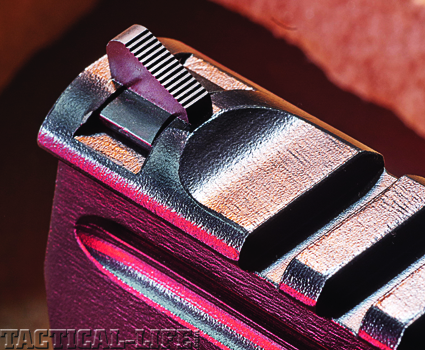
A fixed serrated ramp front sight sits atop the six-inch polygonal rifled barrel.
Advertisement — Continue Reading Below
One enhancement that makes the Desert Eagle so easy to shoot accurately is its trigger. Although single-action in design it has a decidedly two-stage feel to it. The first-stage is all take-up until you get to a point of increased resistance. This second stage broke crisply at 4 pounds on my test sample. MRI calls their trigger the Adjustable Trigger Mechanism (ATM). The location of the transition between stages may be adjusted to be at any point within the trigger travel, by travel adjustment. The trigger travel adjustment is achieved by inserting a screwdriver through the magazine housing opening to turn the ATM adjustment. This type of trigger for this pistol makes all the sense in the world. There should be a certain amount of take up for the shooter to prep before the hammer falls. While the Desert Eagle can be carried with the hammer cocked and the thumb safety engaged the MRO manual recommends carrying the gun with the chamber empty. I found the easiest way to disengage the thumb safety was with my weak hand thumb as this did not require me to change my shooting grip.
Shooting Impressions
Shooting the Desert Eagle is quite an experience! In fact, when I was assigned this article I was really not looking forward to shooting the gun. My theory has always been is a .45 does not offer enough power I’m going to go straight to a rifle. That being said, I don’t spend time fishing or trekking around bear country where carrying a rifle could be a real encumbrance and having a Desert Eagle in a shoulder holster might be the only deterrent from having a bruin turn your leg into a tasty drumstick.
Advertisement — Continue Reading Below
So shooting a handgun chambered for a cartridge that generates roughly the same energy as a 5.56mm NATO round or twice the energy of a .45 ACP or three times that of a 9mm has to be unpleasant right? Actually, it’s not that bad. Once you get used to the huge explosion that happens two or so feet from your face you’ll be fine. There is nothing about the Desert Eagle that makes it hurt to shoot. First of all it weighs 4.5 recoil-absorbing pounds. Additionally the gun is gas operated and that spreads the recoil impulse over a longer period as the gun cycles. Just like shotguns, gas operated semi-autos always shoot softer than pumps or break action guns. By design and necessity the grip is overly large with wide front- and backstraps that distribute the recoil over a wider surface area. It took a few magazines of ammunition to get used to the way the gun feels and after that I was able to settle down and start firing some groups for record. I have to say, shooting the Desert Eagle is the most fun that I’ve had with a handgun in recent memory.
The Desert Eagle manual warns shooters that they need a firm grip for the gun to operate properly. Big bore revolver shooters that are used to letting the gun roll in their hands will have to change their shooting styles to more of a locked “Weaver Style” hold. It is imperative that the pistol has a firm grip to recoil against otherwise it will stovepipe.
 Magnum Research ships the Desert Eagle with a 5 in 1 tool. It can be used to ream accumulated fouling from the gas cylinder of the autopistol.
Magnum Research ships the Desert Eagle with a 5 in 1 tool. It can be used to ream accumulated fouling from the gas cylinder of the autopistol.
Advertisement — Continue Reading Below
CorBon’s 165-grain JHP was downright pleasant to shoot with the light projectile generating comparatively light recoil. However, it was the only load I tried that did not function 100% in the Desert Eagle. While it extracted and ejected 100% it short stroked and did not feed a new cartridge into the chamber about 30% of the time. I’m sure that if you need your Desert Eagle to function with this load that the springs could be adjusted or replaced. Probably a copious amount of good lubricant would also be helpful but honestly if you need to download your .44 Mag that much maybe you’d be better off with a .45?
Designed for heavily muscled and thick boned game the 180-grain CorBon Hunter had surprisingly light recoil yet churned up 1,122 foot pounds of energy (fpe). The 240-grain Hunter load produces a little more energy but also has a little sharper recoil. Its accuracy was phenomenal and this would be my selection if I were carrying the Desert Eagle into bear country.
Hornady loads some 240-grain XTP bullets specifically for the Magnum Research Desert Eagle. This load shoots well and functioned 100% however at 25 yards most of my groups printed about 4 inches high. It wasn’t just this load though—almost all of my loads printed groups that were high at 25 yards. Thinking that maybe the sights had been regulated for a longer distance I moved my target out to 50 yards. These groups were between 6 and 8 inches high so it became apparent that I need a taller front sight for pinpoint accuracy at between 25 and 50 yards. One pleasant surprise was that I fired a number of 50-yard groups under 3 inches. In fact, most of my 25-yard groups showed better accuracy than some of my custom built 1911’s. I was impressed.
Advertisement — Continue Reading Below
Final Notes
The good news is that there is a rail on top of the barrel to facilitate the mounting of optics. While a scope of some sort may help the shooter realize the Desert Eagle’s wonderful accuracy potential it will add bulk, make it harder to comfortably carry and ruin the racy lines of the gun.
The Desert Eagle is an incredibly versatile platform. Once you’ve purchased a Mark XIX Desert Eagle you can change the barrel length or the caliber in seconds—providing that you have the right components. MRI’s Desert Eagle is available in six different configurations—.357 Mag, .44 Mag or .50 AE, each with a 6-inch barrel (standard configuration) or with a 10-inch barrel. Purchase one Desert Eagle and you have the platform to build the other five guns. Barrels, magazines and in some cases the bolt assembly need to be changed to convert to another caliber.
Advertisement — Continue Reading Below
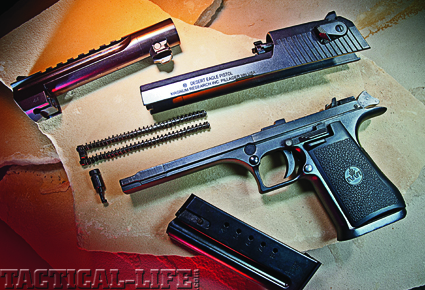
The Mark XIX fieldstrips easily without any special tools. Its robust subassemblies make it unlikely to fail.
I can’t decide what I like best about the Magnum Research IWI-made Desert Eagle. It is one of those guns whose design I marvel at each time I pick it up. Then too it is impeccably machined with each part possessing superior fit and finish. It is wonderfully accurate. But probably what I liked most about the gun was that it was just a ton of fun to shoot! For more information on the Desert Eagle and the rest of the Magnum Research product line, call 508-635-4273 or check out their website at magnumresearch.com.

